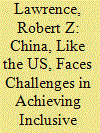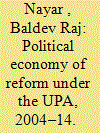|
|
|
Sort Order |
|
|
|
Items / Page
|
|
|
|
|
|
|
| Srl | Item |
| 1 |
ID:
171884


|
|
|
|
|
| Summary/Abstract |
For more than three decades the goal of becoming “the factory of the world” has been at the core of China’s development strategy. This strategy, in combination with high rates of domestic investment and low rates of consumption, has made Chinese production the most manufacturing intensive in the world. But as its wages have risen, China’s competitiveness in the most labor-intensive manufacturing industries has eroded. Its ability to assemble products remains a major source of its exports, but it has also tried to shift toward more sophisticated value-added production domestically. Chinese domestic spending has shifted away from investment toward consumption as citizens’ income has grown. Like Americans, Chinese are also spending more on services than on manufactured goods. All of these changes are fundamentally altering the structure of China’s production, reducing the role of manufacturing and increasing the skill levels of workers in manufacturing. This paper reviews the challenges posed by these developments for China’s long-term goal of achieving more inclusive growth. It presents evidence that the commonly held perceptions that Chinese manufacturing employment growth is robust are wrong. In fact, such growth has peaked and China is now following a pattern of structural change that is typical of a more mature emerging economy, in which the share of employment in manufacturing declines as workers are increasingly employed in services.
|
|
|
|
|
|
|
|
|
|
|
|
|
|
|
|
| 2 |
ID:
118420


|
|
|
|
|
| Publication |
2012.
|
| Summary/Abstract |
For six decades, China's central authorities have promoted development in ethnic regions through special fiscal allocations with the idea that economic development is the key to national integration and inter-ethnic harmony. Yet, inter-ethnic tensions and violence persist in China. Focusing on historical changes to fiscal allocations as the principal policy instrument used by Beijing to promote development in ethnic areas, this analysis finds these changes mirror broad shifts in the country's national development strategy. As the study argues, this pattern reflects an approach to development policy in ethnic regions whereby policies serve central objectives consistent with a policy process for determining the fiscal allocations to ethnic regions that has been both centrally concentrated and non-participatory. With evidence that this "non-engaging" approach may be exacerbating ethnic tensions, Beijing has made efforts to introduce more "inclusive" approaches to determining policies for ethnic regions; however, whether these approaches will be institutionalized remains unclear.
|
|
|
|
|
|
|
|
|
|
|
|
|
|
|
|
| 3 |
ID:
190299


|
|
|
|
|
| Summary/Abstract |
The two decades either side of the global financial crisis have seen a remarkable surge and an equally remarkable reaction to global inequalities. This has played some part in fuelling the recent populist backlash against globalisation. In response, many global institutions and some national governments have embraced the concept of inclusive growth – proposing a policy agenda designed to share the benefits of economic growth and development more equitably. This paper argues that the current debate about inclusivity suffers from two major misspecifications that weaken the concept and undermine the prospect of the economic and political goals it stands for being achieved. For inclusivity to be meaningful and sustainable it must be understood in multidimensional terms, but attaching it to orthodox thinking on growth continually draws the debate back to narrow economic considerations. The concept has also been hampered by ‘methodological nationalism’, whereby policies for inclusivity are considered predominantly at the national level without adequate attention being given to the multilateral dimensions of inclusivity in a world of global interdependence. To be coherent and applicable, inclusive growth must be (re)conceived multilaterally and embrace a more multidimensional notion of inclusive development that hinges around a meaningful conception of human wellbeing.
|
|
|
|
|
|
|
|
|
|
|
|
|
|
|
|
| 4 |
ID:
123869


|
|
|
|
|
| Publication |
2013.
|
| Summary/Abstract |
This article measures the overall inclusive growth of a city by considering changing trends in key economic variables (that is, poverty, inequality, economic growth, education, employment, unemployment and the standard of living index) based on the 'Borda ranking' and establishes a relationship between city economic growth and overall city inclusive growth. Based on data for 52 large cities in India, this article finds that higher urban economic growth is associated with an increase in the growth rate of urban inequality, a reduction in the growth rate of urban poverty and a lower level of overall inclusive growth of a city, that is, urban economic growth is not inclusive.
|
|
|
|
|
|
|
|
|
|
|
|
|
|
|
|
| 5 |
ID:
157063


|
|
|
|
|
| Summary/Abstract |
This article examines the recent trends of opportunities available for women in Sri Lanka in accessing the labour force by using the Social Opportunity Function presented by Ali and Son (2007). Opportunity curves were constructed for women and men separately to assess the equity-impacts of access opportunities to be in the labour force across different expenditure groups. Opportunity index (OI) (average opportunities available to the population) and the Equity Index of Opportunity (EIO) (how opportunities are shared or distributed among the population) calculated for both sexes to quantify the precise magnitude of the change. Household Income and Expenditure Survey (HIES) data produced by the Department of Census and Statistics of Sri Lanka was the main data source. Construction of Opportunity Curves revealed that opportunities for women in accessing labour force have declined over time across all expenditure groups. But it is more remarkable for women in the lower expenditure deciles. In the case of men, mixed results could be observed for different expenditure deciles. Regardless of the sex, average opportunities to access the labour force, OI and EIO have deteriorated over the time period considered.
|
|
|
|
|
|
|
|
|
|
|
|
|
|
|
|
| 6 |
ID:
133442


|
|
|
|
|
| Publication |
2014.
|
| Summary/Abstract |
On 16 May 2014, Narenda Modi assured India that he would go along the inclusive Growth path. Supposedly already being taken by the UPA government for the past decade. " Government is for the common man…. There is no enemy we will want to take everyone along"
Even earlier, on September 26, 2013, attending the birthday celebration of Mata Amritanandamayi at Kollam, Modi had his own point on inclusive Growth.
|
|
|
|
|
|
|
|
|
|
|
|
|
|
|
|
| 7 |
ID:
173336


|
|
|
|
|
| Summary/Abstract |
Mongolia's transition to a democratic, market economy has created widespread change, especially among pastoral herders. Pastoralists have been depicted as archaic and independent ‘nomads’ who exist outside the modern economy. Still, pastoral culture is a key asset in tourism products and advertising. Tourism could provide fair economic benefits, but inclusive growth depends on how shareholders participate. Using interviews with tour company employees, I investigate how tour companies incorporate pastoralists into their products. The results demonstrate several barriers to inclusive growth. Companies feel individually responsible for managing tourism assets, and to maintain the guise of pastoral authenticity, they limit pastoralists’ participation in business through informal and contingent work contracts. These contracts reveal problematic asymmetry and give pastoralists little job security, control, or access to employee benefits. These circumstances oppose inclusive growth paradigms and demonstrate elements of precarious work. The shared interest in maintaining pastoral culture may unify this fragmented industry.
|
|
|
|
|
|
|
|
|
|
|
|
|
|
|
|
| 8 |
ID:
139090


|
|
|
|
|
| Summary/Abstract |
Electoral success during the reform process requires maintaining a prudent balance in meeting the requirements of the two basic state functions of accumulation and legitimacy. Initially, the Congress-led UPA government was the unintended beneficiary of the economic acceleration resulting from a global boom and the earlier economic reforms in aid of accumulation. The growth acceleration, however, also escalated rising expectations. In the effort to advance its legitimacy in order to assure continuance in power, the UPA government emphasized a distributive strategy to the neglect of accumulation. However, the rupture in growth acceleration because of external shock and internal economic mismanagement aggravated the loss of legitimacy stemming from a series of corruption scandals. The consequence was the emergence of an enormous “gap” between rising expectations and the existing reality of economic stagnation and high inflation. It is in the context of this gap that the Congress Party suffered its most severe electoral defeat in history.
|
|
|
|
|
|
|
|
|
|
|
|
|
|
|
|
|
|
|
|
|